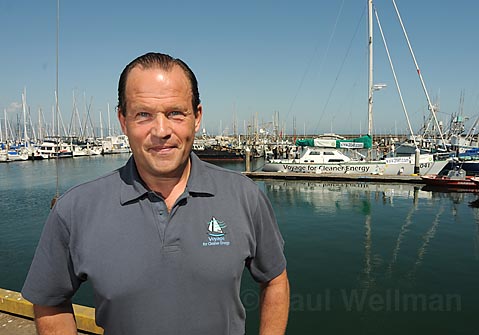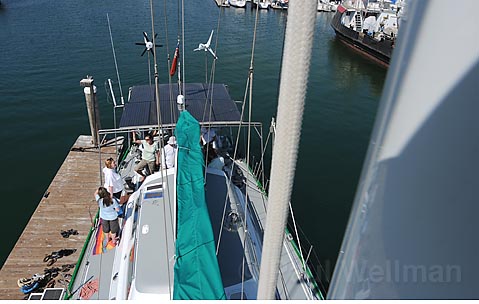Polar Adventurer Brings Sustainable Yacht to SB

The yacht known as 2041 blew into the harbor on Sunday, May 18, in the first leg of its five-year voyage to promote sustainability, a strategy devised by polar explorer Robert Swan, whose lecture tour will shadow the yacht as they both travel around the world. The highly entertaining Brit spoke at the Santa Barbara Maritime Museum on Sunday, and will speak at UCSB on Wednesday, May 21. He first came to international attention after leading a 900-mile Antarctic hike to the South Pole without benefit of such high-tech amenities as radio or other communications or navigational devices, just sextants. His yacht’s name refers to the year when an international treaty that put a moratorium on mining and drilling in the Antarctic is due to expire. Swan does not want to see mining resume in the Antarctic because of the environmental damage it would wreak.
Swan’s Voyage for Renewable Energy was launched from San Francisco on April 8, stopping in several ports along the way. The 2041 will be docked in the Santa Barbara harbor until mid-week. Her Kevlar sails are laminated with plastic from 20,000 used drink bottles, a project Swan undertook with the Coca-Cola company, and when it is not under sail it runs on biodiesel and vegetable oil.
While the yacht’s crew gave tours of the 2041, Swan, who also makes money as a corporate motivational speaker, regaled a rapt audience of a few dozen people with tales of adventure from when he and his teammates walked to the South Pole, after which he led a second team from ice-covered land across ice-covered ocean to the North Pole, earning him the distinction-among many others since then–of being the first to walk to both. Swan claimed that the only reason he went to the North Pole was to maintain a high enough profile and enough credibility to be able to broadcast his message that people must make an effort to protect the ozone layer from depletion. That having been accomplished-the ozone hole is still there, but it has stabilized-he has turned his attention to global warming, though he wasn’t thinking about it at the time, even though one of the more terrifying challenges that he and his team underwent were unseasonably warm temperatures that caused the frozen ocean to start thawing in April, rather than August. In order to beat the melting, they walked for 40 hours straight, seven days in a row, and were saved finally by a change in the wind that refroze the ice.
Swan described meeting world leaders at the first two World Summits on Sustainable Development. “They always say the same thing to me, world leaders. ‘Well done, Robert! Carry on!” I like them.” (Which he has, leading a corporate expedition to Antarctica, and establishing a energy self-sufficient educational and research center there.) However, Swan said he is hoping the next president will announce that it is his or her goal to make the US energy self-sufficient in the next ten years. “Then you don’t have to go beat up the Iraqis anymore,” he said.
Swan also noted that he spent a few hours biking in Santa Barbara on Sunday morning “and didn’t see a lot of solar power or wind generators. We’ve got to get into it.” However, he asked how many in the audience had calculated their carbon footprint, and was impressed when six people raised their hands.
Noting the record breaking-off of 160 square miles of Antarctic ice, and the recent listing of the Polar Bear as endangered, and the fact that when the 2041 sails through the Bering Straits it will do so in three months rather than three years it once took, because the strait is thawing, Swan said, “It might be depressing to watch it all sail by, but we try to make it positive.”

After Swan’s talk, the audience trooped down to the dock for a tour of the 2041, where all of the electrical equipment, from refrigerators to computers, is powered exclusively by the yacht’s two wind turbines and eight solar panels, and stove runs on alcohol rather than gas. Flat panel LEDs (light emitting diodes) provide the light below deck. “They put out a ton of light,” said Maura Fallon-McKnight, the communications director among the five-member crew. The 2041 sleeps 12 and frequently carries graduate students or other passengers interested in learning about, experimenting with, and networking on topics related to saving the world from global warming. To those who raised the question of whether vegetable oil is a good idea, considering the degree to which it supplants food crops, Maura responded that these are important questions, and it’s a sign of hope that people are asking them. “We weren’t even having these discussions five years ago,” she said.
From here, the 2041 is headed to the Panama Canal, and is due to head up the Eastern Seaboard in fall-election season, he noted-and on around the world, hoping to make it to China in time for the 2012 World Summit on Sustainability.



